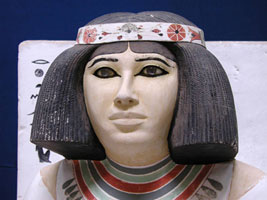Meidum (Maidum) is the location of a necropolis used during the Old Kingdom, particularly in the fourth dynasty by Sneferu and members of his family. The site includes one pyramid and a number of mastaba tombs and it lies to the south of Giza and Memphis.

- Pyramid of Sneferu
- Satellite pyramid
- Mortuary temple
- M17: Mastaba of unknown noble
- M16: Mastaba of Nefermaat I
- M6: Mastaba of Rahotep
Mastabas of Meidum
A number of the mastabas built at Meidum were unfinished and never used for burials, possibly because Sneferu abandoned the site in favour of Dashur. However, there are a few interesting mastaba tombs.
M6: Mastaba of Rahotep
Rahotep and his wife Nofret were buried in mastaba M6. The outside of this mastaba is decorated with the “serek” (palace facade). Inside the mastaba there is a small shrine for Rahotep and one for his wife. A false door in the shrine of Rahotep gives his titles as “King’s Son” and “Priest of Heliopolis” and the walls are decorated with scenes of the prince hunting and fishing.

The two shrines were sealed off and so were remarkably well preserved. They also contained two beautifully painted statues depicting the couple. Rahotep has reddish-brown skin and Nofret has creamy white skin. This has prompted some fanciful claims that the statues were repainted by those wishing to pretend the ancient Egyptians were white. In fact, their colouring reflects the common practice in Egyptian art of depicting men with darker (usually red tinged) skin and women with lighter (often yellow tinged) skin.


M16: Mastaba of Nefermaat
This mastaba was the burial place of Nefermaat I (the son of Sneferu) and his wife Atet. The mastaba was built from mudbrick, but the inner walls were lined with limestone. Two small chapels or shrines were set into the eastern part of the mastabas; one for Nefermaat and the other for Atet. The chapels were beautifully decorated with scenes of hunting, fishing and farming and the western wall of each chapel contained an elaborate and beautiful false door.

The mastaba of Nefermaat I is famous because of the beautiful wall paintings. Sculptors cut the designs deep into the plaster and then filled the incisions with coloured paste. This technique was labour intensive and the paste had a tendency to crack and fall away so it was soon abandoned. However, some of the scenes created in this manner are exceedingly beautiful.

The shrine of Atet contains a scene known as the “Meidum Geese” which is particularly lovely and is generally considered to be one of the great works of art of the Old Kingdom. Recently it has been suggested by an Italian researcher that the Meidum Geese is a late forgery covering an older painting. This highly speculative and unproven theory is rejected by many experts who have noted that perpetrating such a crime under the watchful eye of Auguste Mariette would have been quite an achievement!
M17: Mastaba of an unknown noble

The largest mastaba at Meidum is that of an unknown noble who was probably one of the sons of Sneferu. Access to the burial chamber is via a tunnel left by tomb robbers in antiquity. The huge blocks of stone that sealed the original entrance are still in place. The burial chamber is undecorated but contains the first known example of a red granite sarcophagus. Unfortunately, the sarcophagus is not inscribed so we have no idea who it was intended for.
Bibliography
- Dodson, Aiden (2016) The Royal Tombs of Ancient Egypt
- Lehner, Mark (1997) The Complete Pyramids
- Malek, Jaromir (2000) “The Old Kingdom”, in The Oxford History of Ancient Egypt Ed I. Shaw
- Verner, Miroslav (1997) The Pyramids
Copyright J Hill 2010